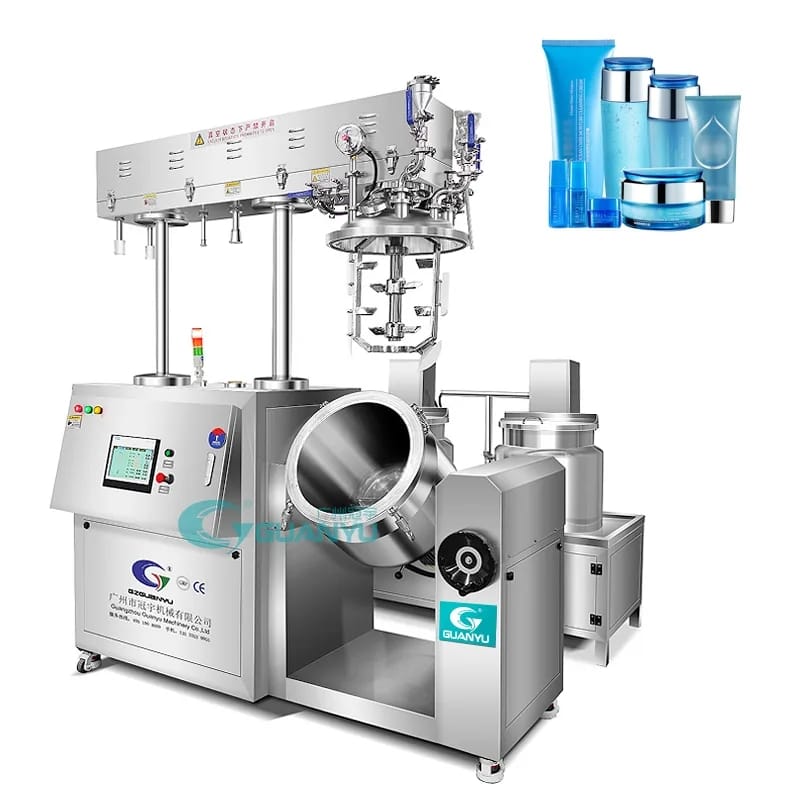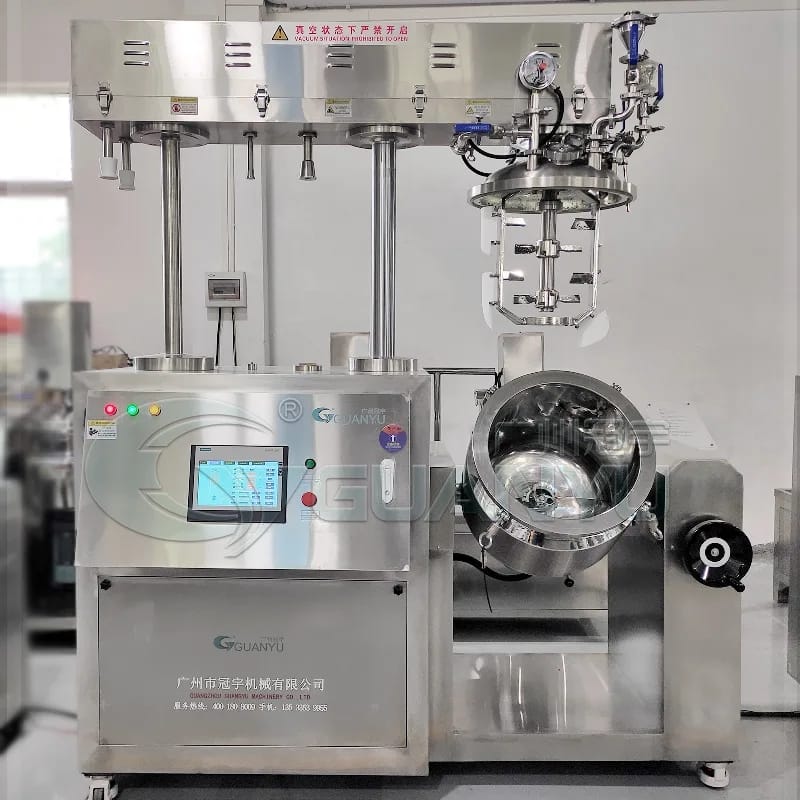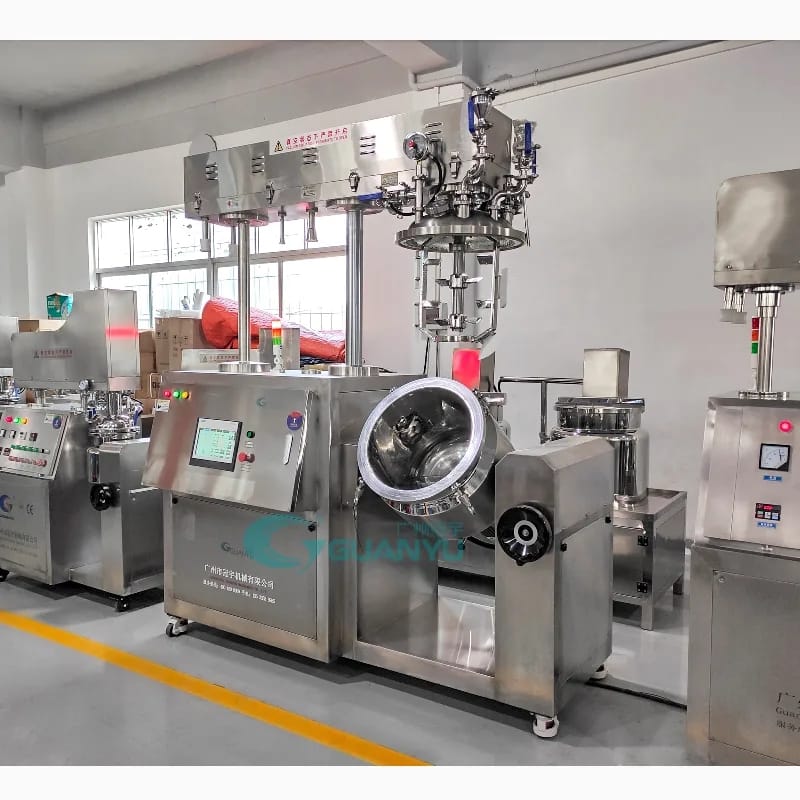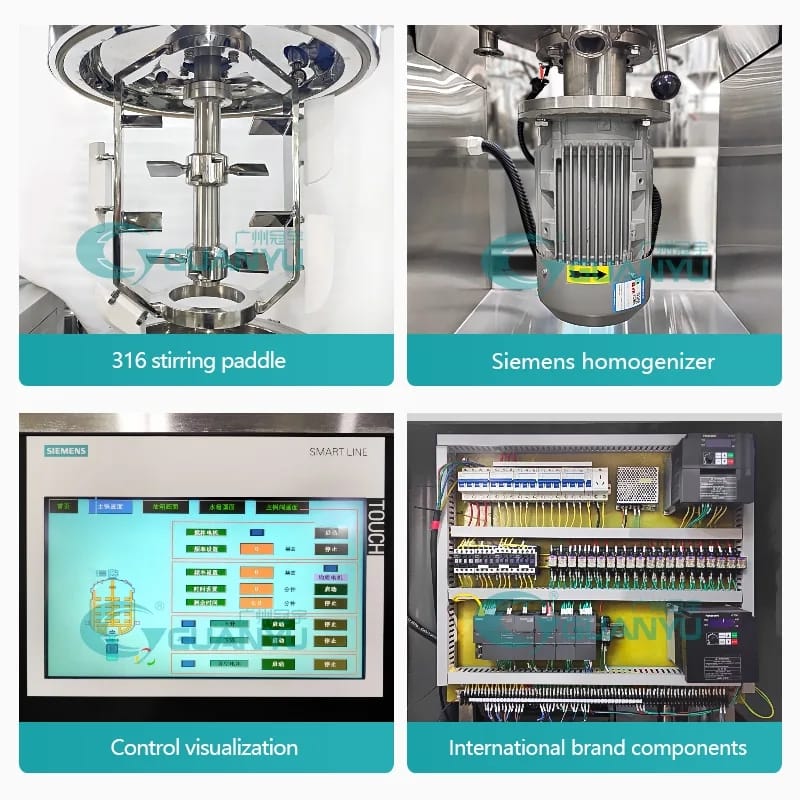O Guia Ultimate para o Homogenizador de Emulsificantes 50L para Produção Cosmética
Emulsifier homogenizers are essential pieces of equipment in the cosmetics industry, designed to create stable mixtures of immiscible liquids, such as oil and water. These devices facilitate the emulsification process, wherein the droplets of one liquid are dispersed within another, resulting in a homogeneous product. This technology is crucial for producing a variety of cosmetic formulations, including creams, pomadas, loções, toothpastes, and gels. The significance of emulsifier homogenizers lies in their ability to enhance product stability, textura, and appearance, which are vital attributes in cosmetic formulations.

The principles of emulsification and homogenization, while related, are distinct processes. Emulsification is the process of combining two or more liquids that typically do not mix, requiring an emulsifying agent to stabilize the blend. In contrast, homogenization is the mechanical process that reduces particle size and promotes uniform distribution within a mixture to improve overall quality and consistency. Both processes are critical for producing high-quality cosmetics that meet consumer expectations.
The 50L emulsifier homogenizer is a notable equipment choice for cosmetics manufacturers, offering a capacity that suits medium to large-scale production. Its efficient design allows for the creation of large batches while maintaining precise control over the emulsification and homogenization processes. The 50L capacity is particularly beneficial for companies looking to enhance their production efficiency without sacrificing quality. This piece of equipment further supports cosmetic producers in achieving consistent results, enabling innovative formulations that cater to evolving consumer demands.
Em essência, understanding emulsifier homogenizers and their fundamental processes is key for anyone involved in cosmetics production. The integration of the 50L emulsifier homogenizer into manufacturing workflows represents a significant step toward enhancing product quality and production efficiency in the highly competitive cosmetics market.
Features and Specifications of the 50L Emulsifier Homogenizer

The 50L emulsifier homogenizer represents a vital piece of equipment in cosmetics production, and its features significantly influence the quality of the final products. One of the notable construction materials used is stainless steel, which ensures durability and resistance to corrosion. This is particularly important in cosmetic manufacturing where contamination must be minimized. The design often incorporates a double jacketed vessel, allowing temperature control during the mixing process, which is essential for emulsions that require heating or cooling.
Power requirements for the 50L emulsifier homogenizer typically range from 5 para 15 HP, depending on the specific model and intended application. Adequate power facilitates efficient processing of varying viscosities, ensuring that high-quality emulsions are more readily achieved. The operating principles behind the emulsifier rely on both mechanical shear and hydraulic forces, which work together to achieve a homogeneous mixture of oil and water phases, thereby optimizing the emulsification process.

An important design specific to many 50L homogenizers is the incorporation of vacuum operations. This feature enables the removal of air from the mixture, which is crucial for maintaining product stability and extending shelf life—hallmarks of quality in cosmetic formulations. Além disso, the ease of cleaning is a design element that cannot be overlooked. The inclusion of quick-disconnect fittings and smooth surfaces makes the equipment easier to maintain, reducing downtime between batches and allowing for safe switchovers when varying product types.
Each of these features directly contributes to the overall performance of the homogenizer, ensuring that the emulsions produced meet both regulatory standards and customer expectations. These carefully engineered specifications play a pivotal role in ensuring product consistency, efficacy, and safety, which are paramount in the competitive cosmetics industry.
Applications of the 50L Emulsifier Homogenizer in Cosmetics Production

The 50L emulsifier homogenizer plays a crucial role in the cosmetics production industry by facilitating the formulation of a wide variety of products, including creams, loções, pomadas, toothpastes, and gels. This equipment is engineered to blend, emulsionar, and stabilize mixtures of oils and water, thereby ensuring that final products have consistent texture, aparência, and performance. One notable application is in the manufacture of moisturizing creams where the emulsifier homogenizer allows for the uniform dispersion of active ingredients, enhancing the product’s effectiveness and sensory attributes.
Por exemplo, in the formulation of a high-quality facial moisturizer, the 50L emulsifier homogenizer efficiently combines water with oils and emollients. This process not only creates a stable emulsion but also contributes to a creamy texture that enhances user experience. De forma similar, when producing lotions, the machine’s capability to break down particle sizes ensures a smooth finish and prevents separation, which is essential for both aesthetic appeal and functionality.
Além disso, the use of the emulsifier homogenizer extends to the development of hair care products. In shampoos and conditioners, it assists in evenly distributing conditioners and surfactants, leading to improved performance and consumer satisfaction. The machine’s impact is evident in case studies where brands observed marked improvements in the stability and performance of their formulations post-implementation of the emulsifier homogenizer.
Regulatory considerations are vital when using emulsifiers in cosmetics. Manufacturers must adhere to guidelines set by regulatory bodies to ensure that emulsifiers comply with safety standards. This has implications for product labeling, transparency concerning ingredient sourcing, and active compliance with specified limits on specific emulsifiers. Such considerations ensure that the end product is not only effective but safe for consumer use.
Conclusão
Selecting the right emulsifier homogenizer is a critical decision for any business engaged in cosmetics production. The choice of equipment directly impacts the quality of the end product, efficiency of production processes, and ultimately, customer satisfaction. When evaluating options, businesses must consider multiple factors including production scale, budget constraints, and specific formulation requirements. Por exemplo, a 50L homogenizer can effectively cater to medium to large-scale production, ensuring consistency and stability in the cosmetic formulations.
Adicionalmente, the importance of matching the emulsifier homogenizer with the specific viscosity and texture requirements of cosmetic products cannot be overstated. Products such as creams, loções, and serums often require distinct processing techniques, which will be best supported by high-quality homogenizers designed for such applications. Investing in a reliable emulsifier not only enhances product performance but also aids in maintaining compliance with industry standards and regulations.
Além disso, while the initial investment in advanced equipment might seem substantial, the long-term benefits often outweigh these costs. By choosing a robust 50L emulsifier homogenizer, companies can achieve operational efficiency, reduce waste, and improve overall product quality, which can translate into increased customer loyalty and market competitiveness. The capacity for innovation and adaptation to changing market demands is also enhanced when equipped with state-of-the-art technology.
Em essência, businesses in the cosmetics industry are encouraged to thoughtfully assess their production needs and consider the role that quality emulsifier homogenizers can play. Taking into account factors such as production scale, budget, and product specifications will aid in making an informed investment that supports future growth and success in the increasingly competitive cosmetics market.

Obrigado pela sua partilha. Estou preocupado porque me faltam ideias criativas. É o seu artigo que me deixa cheio de esperança. Obrigado. Mas, Eu tenho uma pergunta, pode me ajudar?
Seu ponto de vista me chamou a atenção e foi muito interessante. Obrigado. Eu tenho uma pergunta para você.
Obrigado pela sua partilha. Estou preocupado porque me faltam ideias criativas. É o seu artigo que me deixa cheio de esperança. Obrigado. Mas, Eu tenho uma pergunta, pode me ajudar? https://accounts.binance.com/fr/register?ref=GJY4VW8W
Seu ponto de vista me chamou a atenção e foi muito interessante. Obrigado. Eu tenho uma pergunta para você.
Seu artigo me ajudou muito, existe mais algum conteúdo relacionado? Obrigado!
Seu ponto de vista me chamou a atenção e foi muito interessante. Obrigado. Eu tenho uma pergunta para você.
Você pode ser mais específico sobre o conteúdo do seu artigo? Depois de ler, ainda tenho algumas dúvidas. Espero que você possa me ajudar.
Obrigado por compartilhar. Eu li muitos dos seus posts, legal, seu blog é muito bom. https://accounts.binance.com/pt-BR/register-person?ref=IJFGOAID
Seu ponto de vista me chamou a atenção e foi muito interessante. Obrigado. Eu tenho uma pergunta para você. https://accounts.binance.com/da-DK/register-person?ref=V2H9AFPY
Obrigado pela sua partilha. Estou preocupado porque me faltam ideias criativas. É o seu artigo que me deixa cheio de esperança. Obrigado. Mas, Eu tenho uma pergunta, pode me ajudar?
Você pode ser mais específico sobre o conteúdo do seu artigo? Depois de ler, ainda tenho algumas dúvidas. Espero que você possa me ajudar.
Obrigado pela sua partilha. Estou preocupado porque me faltam ideias criativas. É o seu artigo que me deixa cheio de esperança. Obrigado. Mas, Eu tenho uma pergunta, pode me ajudar?
Obrigado pela sua partilha. Estou preocupado porque me faltam ideias criativas. É o seu artigo que me deixa cheio de esperança. Obrigado. Mas, Eu tenho uma pergunta, pode me ajudar?
Seu ponto de vista me chamou a atenção e foi muito interessante. Obrigado. Eu tenho uma pergunta para você.
Você pode ser mais específico sobre o conteúdo do seu artigo? Depois de ler, ainda tenho algumas dúvidas. Espero que você possa me ajudar.
Você pode ser mais específico sobre o conteúdo do seu artigo? Depois de ler, ainda tenho algumas dúvidas. Espero que você possa me ajudar.
Não acho que o título do seu artigo corresponda ao conteúdo haha. Estou brincando, principalmente porque tive algumas dúvidas depois de ler o artigo.
Seu ponto de vista me chamou a atenção e foi muito interessante. Obrigado. Eu tenho uma pergunta para você.
Você pode ser mais específico sobre o conteúdo do seu artigo? Depois de ler, ainda tenho algumas dúvidas. Espero que você possa me ajudar.
Não acho que o título do seu artigo corresponda ao conteúdo haha. Estou brincando, principalmente porque tive algumas dúvidas depois de ler o artigo.
Obrigado por compartilhar. Eu li muitos dos seus posts, legal, seu blog é muito bom.
Não acho que o título do seu artigo corresponda ao conteúdo haha. Estou brincando, principalmente porque tive algumas dúvidas depois de ler o artigo. https://www.binance.info/hu/register?ref=FIHEGIZ8
Seu ponto de vista me chamou a atenção e foi muito interessante. Obrigado. Eu tenho uma pergunta para você.
Obrigado por compartilhar. Eu li muitos dos seus posts, legal, seu blog é muito bom.
Obrigado pela sua partilha. Estou preocupado porque me faltam ideias criativas. É o seu artigo que me deixa cheio de esperança. Obrigado. Mas, Eu tenho uma pergunta, pode me ajudar? https://www.binance.com/en-IN/register?ref=UM6SMJM3
Você pode ser mais específico sobre o conteúdo do seu artigo? Depois de ler, ainda tenho algumas dúvidas. Espero que você possa me ajudar.
Obrigado por compartilhar. Eu li muitos dos seus posts, legal, seu blog é muito bom.
Você pode ser mais específico sobre o conteúdo do seu artigo? Depois de ler, ainda tenho algumas dúvidas. Espero que você possa me ajudar. binância
Seu ponto de vista me chamou a atenção e foi muito interessante. Obrigado. Eu tenho uma pergunta para você.
Seu ponto de vista me chamou a atenção e foi muito interessante. Obrigado. Eu tenho uma pergunta para você.
Você pode ser mais específico sobre o conteúdo do seu artigo? Depois de ler, ainda tenho algumas dúvidas. Espero que você possa me ajudar.
Não acho que o título do seu artigo corresponda ao conteúdo haha. Estou brincando, principalmente porque tive algumas dúvidas depois de ler o artigo.
I don’t think the title of your enticle matches the content lol. Estou brincando, mainly because I had some doubts after reading the enticle.
Não acho que o título do seu artigo corresponda ao conteúdo haha. Estou brincando, principalmente porque tive algumas dúvidas depois de ler o artigo.
Obrigado pela sua partilha. Estou preocupado porque me faltam ideias criativas. É o seu artigo que me deixa cheio de esperança. Obrigado. Mas, Eu tenho uma pergunta, pode me ajudar?
**cofre mental**
Mind Vault é uma fórmula premium de suporte cognitivo criada para adultos 45+. Ele foi cuidadosamente projetado para ajudar a manter um pensamento claro
**cofre mental**
cofre mental é uma fórmula premium de suporte cognitivo criada para adultos 45+. Ele foi cuidadosamente projetado para ajudar a manter um pensamento claro
**respirar**
respirar é uma tintura à base de plantas elaborada para promover o desempenho pulmonar e melhorar a qualidade da respiração.
**respirar**
respirar é uma tintura à base de plantas elaborada para promover o desempenho pulmonar e melhorar a qualidade da respiração.
Seu ponto de vista me chamou a atenção e foi muito interessante. Obrigado. Eu tenho uma pergunta para você.
Obrigado pela sua partilha. Estou preocupado porque me faltam ideias criativas. É o seu artigo que me deixa cheio de esperança. Obrigado. Mas, Eu tenho uma pergunta, pode me ajudar?
Eu aprendi muito com isso. Obrigado.
Não acho que o título do seu artigo corresponda ao conteúdo haha. Estou brincando, principalmente porque tive algumas dúvidas depois de ler o artigo.
Hi there, You have done a fantastic job. I’ll definitely digg it and in my opinion suggest to my friends. I am sure they’ll be benefited from this web site.
Obrigado por compartilhar. Eu li muitos dos seus posts, legal, seu blog é muito bom. https://accounts.binance.com/register-person?ref=IXBIAFVY
Obrigado por compartilhar. Eu li muitos dos seus posts, legal, seu blog é muito bom. https://accounts.binance.com/sk/register-person?ref=WKAGBF7Y
Obrigado pela sua partilha. Estou preocupado porque me faltam ideias criativas. É o seu artigo que me deixa cheio de esperança. Obrigado. Mas, Eu tenho uma pergunta, pode me ajudar?
Obrigado pela sua partilha. Estou preocupado porque me faltam ideias criativas. É o seu artigo que me deixa cheio de esperança. Obrigado. Mas, Eu tenho uma pergunta, pode me ajudar? https://accounts.binance.com/pt-PT/register-person?ref=KDN7HDOR
Seu ponto de vista me chamou a atenção e foi muito interessante. Obrigado. Eu tenho uma pergunta para você.
Seu ponto de vista me chamou a atenção e foi muito interessante. Obrigado. Eu tenho uma pergunta para você.
Seu artigo me ajudou muito, existe mais algum conteúdo relacionado? Obrigado!
Obrigado pela sua partilha. Estou preocupado porque me faltam ideias criativas. É o seu artigo que me deixa cheio de esperança. Obrigado. Mas, Eu tenho uma pergunta, pode me ajudar?
Obrigado por compartilhar. Eu li muitos dos seus posts, legal, seu blog é muito bom.